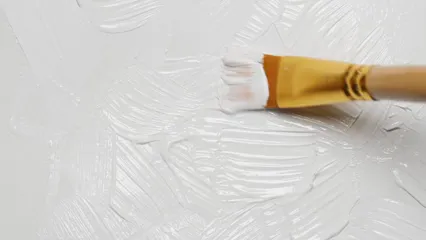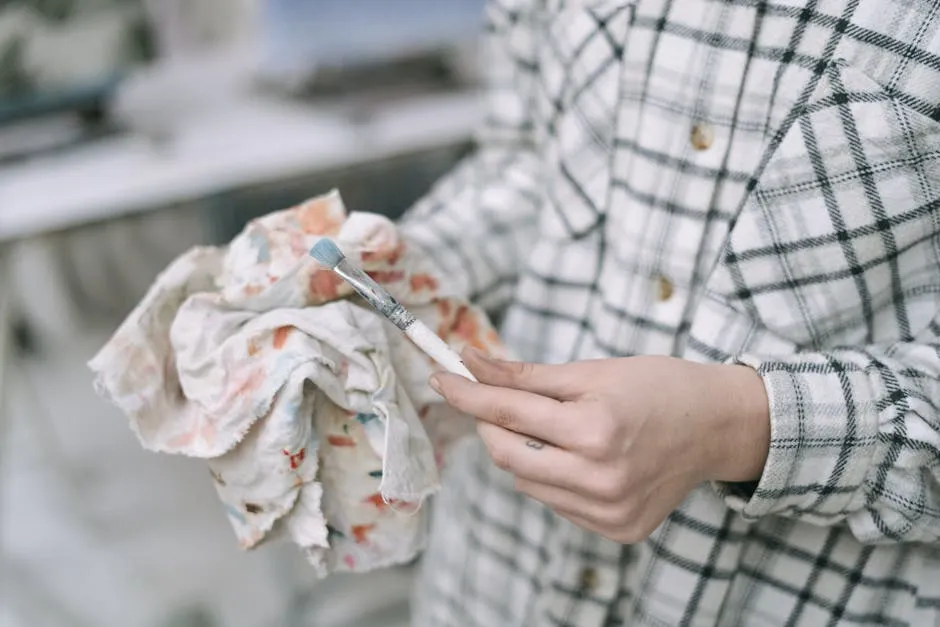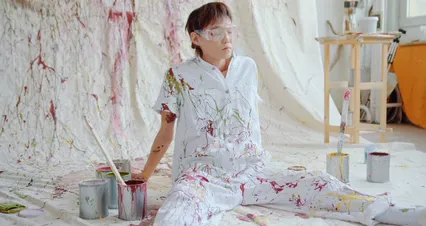
Why Do Painters Wear White? Unraveling the Traditions and Practicalities
Introduction
In the colorful world of painting, one thing often catches the eye: the painter’s white uniform. You might wonder, why white? Is it just an aesthetic choice, or does it carry more weight? The answer is a delightful mix of history, practicality, and tradition. This article takes a closer look at the reasons behind this iconic choice of attire.
The origins of painters wearing white date back to the late 19th century. Union painters adopted this color to create a distinct identity, separating themselves from non-union workers. But that’s not all! Wearing white symbolizes professionalism and skill. A painter who returns with minimal paint splatters on their attire likely possesses a certain level of expertise.
Moreover, white clothing serves practical purposes. It helps conceal splatters from white paint—an everyday occurrence in the profession. In sunny climates, it reflects heat, keeping painters cooler while they work. And let’s not forget the safety aspect; a white uniform acts as a visual cue, warning others to steer clear of wet paint.
So, the next time you spot a painter in white, remember: it’s not just a coincidence. It’s a tradition steeped in significance, practicality, and a touch of whimsy. This article will further unravel the details behind this fascinating topic, because who doesn’t love a good story woven into the fabric of everyday life?

Summary of Key Points
Painters wear white for several compelling reasons, each tied to history, practicality, and professionalism. The tradition began in the late 19th century when union painters adopted white uniforms. This choice helped distinguish them from non-union workers and became a symbol of their commitment to quality.
White clothing conveys cleanliness and skill. When a painter returns from a job with minimal splatters, it indicates experience. Conversely, a uniform covered in paint can signal a seasoned professional, as the more colors seen on their attire might suggest a hard day’s work.
Additionally, wearing white is practical. It camouflages splatters from common materials like primer and spackle. In hot climates, white reflects sunlight, keeping painters cooler. This color also serves as a safety signal, alerting passersby to avoid wet paint zones.
While the reasons for this tradition vary, the symbolism of white remains prominent. It evokes a sense of professionalism, cleanliness, and identity within the painting profession. Painters take pride in their whites, carrying on a custom that continues to spark curiosity and admiration.

Historical Context
The Origins of White Attire
The tradition of painters wearing white can be traced back to various historical influences. In the 17th century, sailors in England wore loose-fitting trousers made from discarded white canvas sails. This practical choice later inspired painters, who appreciated the fabric’s durability and lightness.
By the late 19th century, the International Union of Painters and Allied Trades played a crucial role in solidifying this trend. As union members sought to distinguish their skilled workforce from non-union laborers, adopting a uniform color became essential. White not only symbolized professionalism but also showcased a commitment to quality work. Painters in white could easily signal to clients and employers that they were part of a respected trade, reinforcing their credibility.

Architectural Influences
Architectural trends significantly affected painters’ uniform choices. During the 18th and 19th centuries, many homes were painted white, particularly in the southern United States. This choice had practical implications; white paint helped reflect sunlight, keeping interiors cooler in warm climates. Painters tasked with maintaining these homes often wore white, blending their appearance with the surfaces they worked on.
Moreover, the prevalence of whitewash during this period further cemented the association of the color with painting. Whitewash, a mixture of slaked lime and water, was widely used for both interior and exterior surfaces. It provided a clean, protective layer while also being economical. As painters applied whitewash, it naturally followed that their attire mirrored the color most often used in their trade. The combination of these architectural trends and practical applications created a lasting legacy in painter uniforms that continues today.

Practical Reasons for Wearing White
Camouflaging Paint Residue
One of the most practical reasons painters wear white is to conceal paint splatters from their work. White paint, primer, and spackle are commonly used materials in the industry. Thus, wearing white clothing allows painters to hide those pesky splatters, maintaining a polished appearance even after a long day of work.
Imagine a painter returning from a job site, their attire largely unblemished. This not only indicates skill but also reflects a painter’s professionalism. If a client sees a painter with minimal paint on their clothes, they might think, “This person knows what they’re doing!” Conversely, a painter clad in various colors may signal a hard-working veteran. The condition of their whites tells a story, showcasing their experience and dedication.
In essence, the choice of wearing white is about more than just tradition; it’s a clever strategy to camouflage the inevitable splatters that come with the territory of painting. This practicality allows painters to project an image of competence and professionalism, which is essential in a competitive industry.

Heat Reflection and Comfort
White clothing is a painter’s best friend, especially under the blazing sun. It reflects sunlight, making it a smart choice for those outdoor jobs in hot climates. Imagine sweating profusely in dark colors while trying to perfect that paint job. Yikes! Who needs that kind of discomfort? By wearing white, painters can stay cooler and more comfortable, allowing them to focus on their craft without the added heat. Plus, let’s be honest: nobody wants to feel like a walking sauna when they’re trying to create a masterpiece!

Safety Considerations
Safety is crucial on any job site, and white uniforms play a significant role in keeping painters safe. The visibility of white overalls acts as a warning to others nearby. It’s like wearing a neon sign that says, “Hey, I’m working here! Watch your step!” This high visibility helps prevent accidents, especially in bustling environments where distractions are plenty. So, when you see a painter in white, know that it’s not just a fashion statement; it’s a smart, safety-first choice.

Economic and Practical Benefits
Now, let’s talk money. Plain white clothing is often more economical for tradesmen. It’s less expensive to produce than its colorful counterparts, which require dyeing. Painters can stock up on several sets without breaking the bank.
Additionally, white serves as an unintentional color chart. If a painter runs out of a specific hue, they can simply pull out their trusty whites to find the closest match. It’s a practical solution to a common problem, making the decision to wear white just that much smarter.

Cultural Significance
Symbolism of Cleanliness and Professionalism
In the painting industry, white clothing carries a powerful message. It symbolizes cleanliness and professionalism. Clients associate this color with a tidy, meticulous approach to work. When a painter shows up in white, it speaks volumes about their commitment to delivering quality results. This perception can significantly influence a client’s decision to hire a painter, as the color conveys trust and competence.
Beyond the painting industry, white has long been regarded as a sign of cleanliness across various professions. Doctors and chefs also wear white, reinforcing the idea that this color represents hygiene and professionalism in the workplace. In a world filled with colorful chaos, white stands out as a beacon of order and neatness.

The Story Behind Worn Whites
A painter’s white uniform can tell a story. The condition of these whites often reflects their journey in the trade. A pristine white outfit might suggest a newcomer still learning the ropes, while a well-worn, paint-splattered attire signals a seasoned pro. Each splash of color tells a tale of hard work, dedication, and countless projects completed.
For many painters, their worn whites are badges of honor. They signify experience and skill, showcasing the countless hours spent perfecting their craft. As they move from one job to another, these uniforms gather stories and memories, becoming a tangible representation of their professional journey.
In conclusion, the cultural significance of painters wearing white is rich and multifaceted. It’s a tradition that blends symbolism, storytelling, and practicality, making it an integral part of a painter’s identity. As we continue to appreciate the artistry of painting, let’s not forget the deeper meanings behind those iconic white uniforms.

Should You Wear White for DIY Projects?
Guidelines for DIYers
So, you’re ready to tackle your home painting project. The excitement is real, but what should you wear? You might wonder if you should follow the age-old tradition of wearing white. While it’s not a must, there are some practical tips to consider for your painting attire, whether you choose white or not.
First and foremost, think about comfort. Opt for lightweight, breathable fabrics like cotton. Long sleeves can protect your arms from splatters and the sun. Loose-fitting shirts are great, but avoid overly baggy ones that can brush against wet paint. You don’t want to end up with a surprise mural on your outfit!
When it comes to pants, dig out those old, comfy ones. Denim or canvas works well. Cargo pants are a fantastic choice; they have pockets for tools and brushes. If you’re feeling adventurous, overalls can provide both style and functionality.
Now, don’t forget about your head! A baseball cap or bandanna can keep paint chips out of your hair and shield your eyes from the sun. Speaking of protection, safety goggles are a must. They’ll save your eyes from paint splatters and dust while you work.
As for footwear, grab those close-toed shoes with good traction. You’ll be climbing ladders and walking on slick surfaces, so safety is key. If you’re using a paint sprayer, invest in a paint mask to avoid inhaling fumes. And when working in enclosed spaces, a respirator is vital to protect your lungs.
Lastly, remember that while wearing white can hide certain splatters, it’s not the only option. Choose clothing that you’re okay potentially ruining. It’s all about practicality and feeling good while you unleash your inner Picasso!

The Importance of Proper Tools and Techniques
While what you wear is important, let’s not forget the main event: the actual painting! Quality tools and techniques are what will truly make or break your project. Invest in good brushes and rollers. Cheap tools can lead to streaky finishes and frustration.
Learn the right techniques, like cutting in before rolling. This will give your walls a professional touch, regardless of what you’re wearing. The right paint can also make a difference—choose high-quality products for better coverage and durability.
In short, while wearing white may have its charms, what you really need are the right tools and know-how to create a masterpiece. So, gear up, stay safe, and let your creativity flow!

Conclusion
The tradition of painters wearing white is a captivating mix of history, practicality, and symbolism. Over the years, this choice has become a beloved hallmark of the painting profession. It’s not simply about aesthetics or a quirky fashion statement; it’s a narrative steeped in purpose.
Historically, the practice began as a way for union painters to stand out. White signified professionalism and skill, helping clients identify experienced workers. Today, it serves multiple functional roles. For instance, white attire cleverly camouflages splatters from common painting materials. It also reflects sunlight, making it more comfortable for painters working outdoors, especially in warmer climates.
Moreover, the color white symbolizes cleanliness, reassuring clients that the job will be done neatly. A painter returning from a job site with minimal splatters on their whites indicates a high level of expertise. Conversely, a uniform covered in paint tells a different story—one of hard work and dedication.
As we appreciate the artistry involved in painting, it’s essential to recognize the narrative behind those iconic white uniforms. They embody a rich tradition, merging practicality with a touch of whimsy. So, the next time you see a painter in white, remember it’s not just a uniform; it’s a badge of honor, skill, and history.

FAQs
Why do painters not wear other colors?
Painters typically stick to white for several practical and historical reasons. Firstly, white clothing helps conceal splatters from commonly used materials like primer and spackle, which are often white themselves. This camouflaging effect keeps painters looking professional, even after a long day of work. Historically, the choice of white dates back to the late 19th century, when union painters adopted this color to distinguish themselves from non-union workers. White symbolizes cleanliness and professionalism, offering clients a sense of assurance regarding the quality of work. The tradition has simply persisted throughout the years, creating a lasting identity for painters.
Can I wear white when painting at home?
Absolutely! While it’s not mandatory, wearing white can be a fun nod to tradition. It’s ideal for DIY enthusiasts who want to channel their inner painter while tackling home projects. Just remember, white may show stains more readily, so you might want to wear clothes you don’t mind potentially ruining. If you decide to don white, opt for lightweight, breathable fabrics to stay comfortable. Long sleeves can also protect your arms from splatters. However, the most important thing is to choose clothing that’s functional and allows you to work freely, regardless of color.
How do painters keep their white uniforms clean?
Keeping those whites pristine can be a challenge! Most painters adopt a few simple laundry practices to maintain their uniforms. First, they often wash their clothes immediately after use to prevent stains from setting. Using a good detergent that targets stubborn stains is essential. Pre-treatment with stain removers can also help with particularly tough spots. For the best results, many painters wash their whites separately from colored clothing to avoid any color transfer. Regularly bleaching whites can help maintain brightness, but it’s crucial to check fabric care labels to avoid damage.
Are there any modern alternatives to white uniforms?
Yes, there are modern alternatives! While traditional white remains popular, many painters now opt for durable, breathable fabrics in various colors. Some choose light gray or beige, which can also hide stains while still looking professional. Moreover, brands are developing painter-specific apparel that blends style with functionality. These may include breathable, moisture-wicking materials or stylish designs that allow painters to express their individuality while on the job. Ultimately, the choice boils down to personal preference, comfort, and practicality.
If you’re curious about the reasons behind painters’ choice of white uniforms, you can learn more about why do painters wear white.
Please let us know what you think about our content by leaving a comment down below!
Thank you for reading till here 🙂
All images from Pexels




